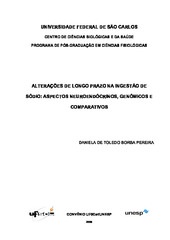Alterações de longo prazo na ingestão de sódio : aspectos neuroendócrinos, genômicos e comparativos

View/
Date
2008-10-10Author
Pereira-Derderian, Daniela de Toledo Borba
Metadata
Show full item recordAbstract
Sodium intake occurs either as a need-free or a need-induced behavior, which is enhanced by repeated episodes of treatments leading to extracellular dehydration or increased levels in natriorexigenic hormones. This enhancement is likely an adaptation to repeated episodic sodium loss mediated by the long-term effects of hormones on brain circuits subserving sodium appetite. The objective of the present thesis was to investigate three aspects of long-term alterations in sodium intake associated to angiotensin (ANG) II: 1) neuroendocrine: the effect of repeated episodes of FURO/CAP on need-induced and need-free sodium intake, 2) genomic: associate hypothalamic renin-angiotensin system mRNA alterations with sodium intake enhancement induced by repeated episodes of water deprivation followed by partial rehydration with water (WDPR), and 3) comparative: sodium appetite in SHR submitted to a single WDPR. Both protocols, WDPR and FURO/CAP, were effective methodologies to enhance sodium intake, not related to systemic changes, suggesting that its mechanisms are due to neural plasticity and salt addiction.
Repeated blockade of Agtr1 receptors by losartan inhibited or abolished the enhancement in the need-free sodium intake produced by a history of FURO/CAP. This result suggests that encephalic ANG II may play a role in the sensitization of spontaneous sodium intake, and perhaps it does not occur in the hypothalamus because it was not correlated to any hypothalamic RAS mRNA alteration in the WDPR protocol. However, hydrated animals with a history of WDPR increased the hypothalamic mRNA encoding of ANG II receptor type-1a (Agtr1a) by 76%. The enhancement in the need-induced sodium intake in the WDPR was related to increased hypothalamic mRNA encoding of angiotensinogen, aminopeptidase N, X Agtr1-associated protein, and ANG receptor like-1 or apelin receptor by 43%, 60%, 36%, and 159% respectively. Thus, the enhancement in the sodium appetite in WDPR was associated with alterations in the hypothalamic gene expression related to RAS. Thus, hypothalamic ANG II and apelin may play a role in the long-term changes of need-induced sodium intake. Moreover, the increased cellular activity that occurred in the subfornical organ, pre-locus coeruleus, and caudal nucleus of the solitary tract is associated with a stronger sodium appetite shown by SHR. These results suggest that increased cellular activity in these areas is correlated with the avid sodium appetite shown by SHR in response to water deprivation. The results suggest that repeated activation of encephalic ANG II receptors, perhaps in different areas, is able to enhance both forms of sodium intake and reinforce encephalic ANG II as a peptide that mediates long-term effects on behavior.